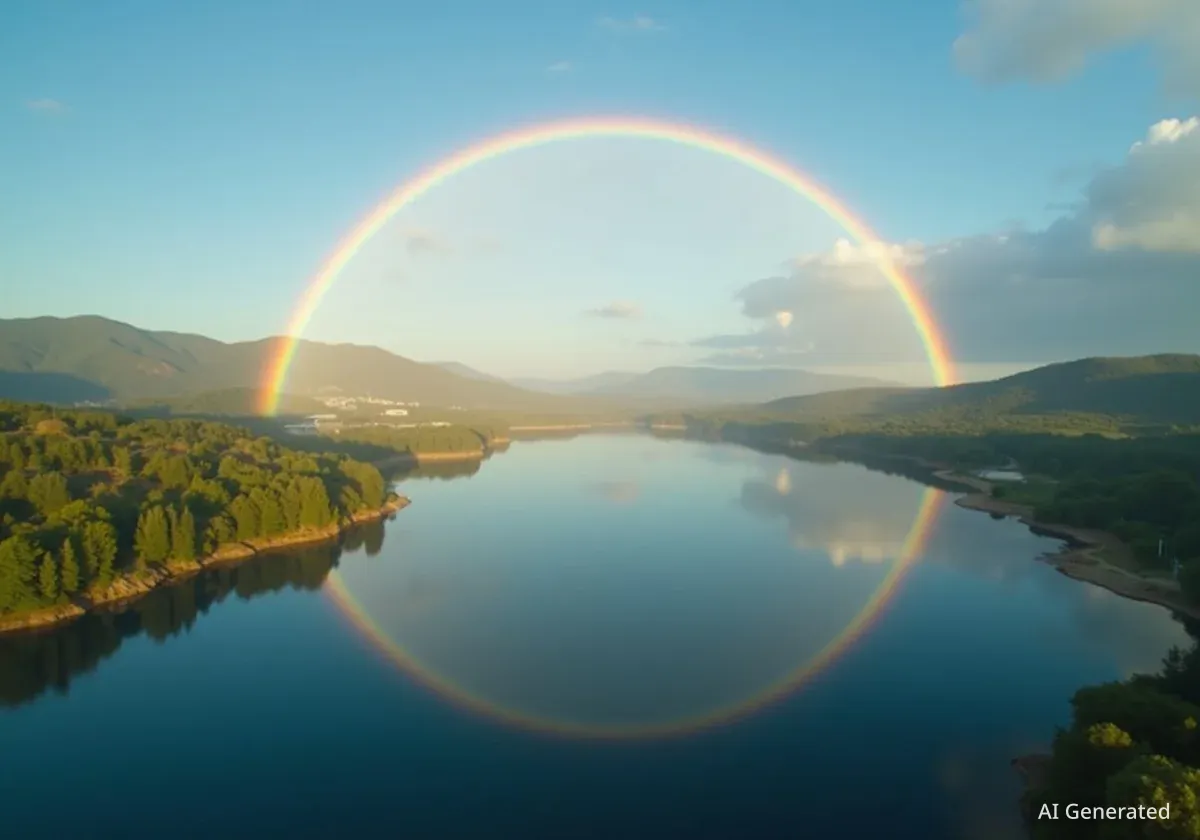A stunning and rarely seen full-circle rainbow captured over a lake in China has won the top prize in the 2025 Standard Chartered Weather Photographer of the Year competition. The image, taken by Geshuang Chen and Shuchang Dong, was selected from over 4,000 entries in the contest's 10th anniversary year.
The winning photograph required a drone to ascend 500 meters through rain, revealing the complete circle of the rainbow—a perspective that is almost impossible to see from the ground. The competition, run by the Royal Meteorological Society, also recognized powerful images of tornadoes, rare clouds, and the impacts of extreme weather across several categories.
Key Takeaways
- Geshuang Chen and Shuchang Dong won the overall prize for their drone photo of a complete circular rainbow in China.
- Jonah Lange's image of a powerful tornado in Texas won the Climate Award, highlighting extreme weather events.
- Lukáš Gallo's photo of rare Kelvin-Helmholtz clouds, resembling ocean waves in the sky, was the winner of the public vote.
- The competition received more than 4,000 submissions from photographers around the world for its 10th anniversary.
A Perfect Circle Above the Lake
The overall winning image, titled "The Glorious Ring," presents a view of a weather phenomenon that few people ever witness. While rainbows are common, the horizon typically hides the bottom half of the arc. To see the full circle, an observer must be at a high altitude with the sun directly behind them and rain in front.
Photographers Geshuang Chen and Shuchang Dong achieved this unique perspective by flying a drone above Lugu Lake in China's Yunnan Province. The drone passed through a curtain of drizzle to capture the shot, perfectly framing a small island in the center of the rainbow's circle.
"It was drizzling on Lugu Lake. I flew my drone to a height of 500 meters, passed through the rain curtain, with my lens facing away from the sun, and captured a complete circular rainbow, which was a ring given by the sun to the lake." - Geshuang Chen, Winner
Rainbows are optical illusions caused by sunlight refracting and reflecting inside raindrops. Because the angle of light is unique to each viewer's position, no two people see the exact same rainbow. This makes the winning photo a capture of a perfect, fleeting alignment of sun, rain, and camera.
The Science of a Full Rainbow
A rainbow is a full circle of light centered on the antisolar point—the point in the sky directly opposite the sun from the observer. From the ground, the horizon cuts off the lower portion of this circle. Only from a significant height, such as from an airplane or a high-altitude drone, can the full 360-degree phenomenon be observed.
Documenting an Unstable Climate
The competition also highlighted the increasing intensity of weather events. The Climate Award was given to Jonah Lange for his photograph of a massive tornado churning up red soil on the plains of West Texas. The image, captured near Sudan, Texas, on April 25, 2025, shows the raw power of the storm.
Lange's photo depicts a spiraling column of dust and wind, a visible collar cloud, and even a smaller satellite vortex nearby. On the day the photo was taken, reports indicated hailstones as large as 3 inches in diameter fell in the area.
Competition judge and meteorologist Phillipa Drew commented on the power of the image. "Everything is becoming more extreme," she said. "This is a good example of an extreme case. It highlights the vastness of weather. We don’t stand much of a chance against that."
The runner-up in the Climate category, Maria del Pilar Trigo Bonnin, captured the devastating aftermath of Typhoon Rai in the Philippines, showing two men navigating a road covered in debris on Siargao Island.
The Public's Favorite and Young Talent
The public vote was won by Lukáš Gallo for his image "Sky Surfing." The photograph captures rare and beautiful Kelvin-Helmholtz clouds, which look like breaking ocean waves in the sky. Gallo spotted the unusual cloud formation while driving in South Bohemia, Czechia, and pulled over just in time to photograph the transient display.
These distinctive clouds, also known as fluctus clouds, form when there is a significant difference in wind speed between two layers of air, creating instability that curls the cloud tops into wave-like patterns. They are a visual indicator of atmospheric turbulence.
Fleeting Formations
Kelvin-Helmholtz clouds are known for being short-lived, often lasting only a few minutes. Capturing them requires a combination of luck and quick thinking, as photographer Lukáš Gallo demonstrated.
In the youth category, Alex Cruz won for his photo "Eruption in the sky," taken from a passenger airplane. The image shows a massive cumulonimbus thunderstorm cloud glowing pink at sunset. The cloud's top has spread out into a classic anvil shape, a sign that its powerful updrafts have reached the tropopause, the boundary between the lower atmosphere and the stratosphere.
More Winners Capture Weather's Diversity
The competition celebrated a wide range of weather phenomena, with winners in several other categories showcasing both beauty and danger.
Other Notable Winners Include:
- Mobile Category Winner: Kyaw Zay Yar Lin's photo shows two fishermen in Myanmar caught in a sudden, intense downpour on Inle Lake.
- Overall Runner-Up: Jadwiga Piasecka captured the immense power of Storm Eunice as it battered the coast of Newhaven, UK, with winds over 80 miles per hour.
- Overall Third Place: Jaroslav Fous photographed a rare and complex lunar halo display, including a 22° halo and a Parry arc, caused by moonlight interacting with ice crystals in the air.
Jadwiga Piasecka's image of Storm Eunice serves as a reminder of the danger of extreme weather. The storm produced England's highest recorded wind gust of 122 miles per hour and caused widespread damage. An isolated figure in her photo emphasizes the sheer scale of the waves crashing against the sea wall.
From the delicate fractal patterns of ice on a frozen lake in India to the chaotic spray of a storm surge in Norfolk, the winning images provide a comprehensive and visually arresting look at the world's weather in its many forms.




